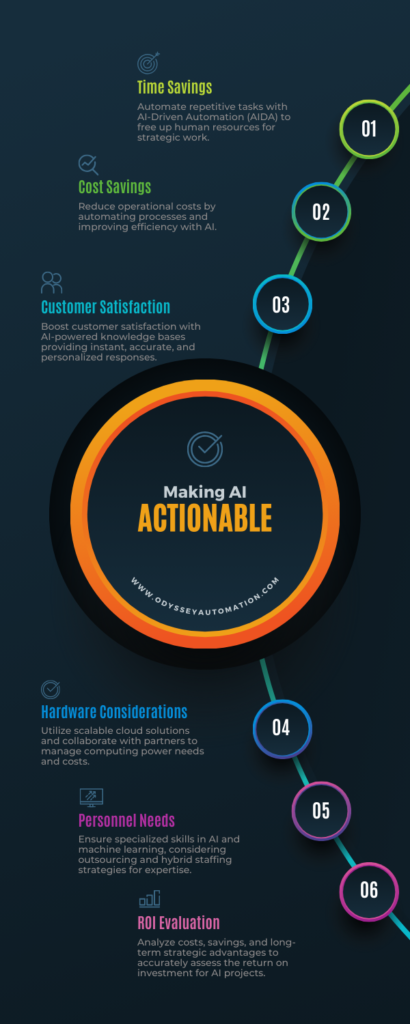 Making AI Actionable
Making AI Actionable
In today’s rapidly evolving business landscape, Artificial Intelligence (AI) has become more than just a buzzword. It’s a transformative force that can drive innovation, efficiency, and competitive advantage. However, many businesses struggle to move beyond the hype or fail to take real action from the results of their models. Here are some practical steps and examples to help business leaders make AI actionable in their organizations.
Identify Specific Business Problems
The first step in making AI actionable is to identify concrete business problems that AI can solve. Instead of trying to implement AI for its own sake, focus on areas where it can deliver tangible value. Areas to consider could be customer segmentation and personalization, demand forecasting and inventory optimization, predictive maintenance, fraud detection and prevention, and more.
Start Small and Scale
Begin with pilot projects that have a clear scope and measurable outcomes. This approach allows you to learn, adjust, and demonstrate value before scaling up. Automated ticket responses would be a great area to target – initially for internal customers (employees) and eventually expanding to external customers.
 Ensure Data Readiness
Ensure Data Readiness
AI systems rely on high-quality, relevant data. Assess your data infrastructure and ensure you have the necessary data to support your AI initiatives. An AI-driven automation (AIDA) system with robust integration capabilities can help to connect your various data sources.
Build Cross-Functional Teams
Successful AI implementation requires collaboration between domain experts, data scientists, IT professionals, process improvement experts, operations, corporate teams, and business leaders. Create diverse teams to drive your AI projects. Partners can provide guidance and augment your teams, if needed.
Invest in AI Education
Educate your workforce about AI’s potential and limitations. This will help generate buy-in and identify new opportunities for AI applications. This can be done through training programs, workshops and knowledge-sharing initiatives. A partner can assist with this.
Choose the Right Tools and Partners
Evaluate whether to build AI capabilities in-house or partner with AI vendors. Consider factors like your existing technical capabilities, budget, and the specificity of your needs. Partnering with an AIDA provider will ensure seamless data delivery and that the results of your AI models are put into action.
Establish Ethical Guidelines
Develop clear guidelines for the ethical use of AI in your organization, addressing issues like data privacy, algorithmic bias, transparency and accountability. As mentioned last week, an AIDA platform can help automate audit tasks and ensure responsible parties are notified of important events.
Monitor and Iterate
Continuously monitor the performance of your AI systems and be prepared to iterate. AI is not a “set it and forget it” solution; it requires ongoing refinement and adjustment.
 Foster a Culture of Innovation
Foster a Culture of Innovation
Encourage experimentation and create a culture where employees feel empowered to suggest and implement AI-driven solutions. An AIDA hack-a-thon is a great way to unearth some surprising opportunities.
Measure and Communicate Impact
Develop clear performance metrics to measure the impact of your AI initiatives and communicate success throughout the organization. An AIDA platform can be used to provide advanced dashboards, reports and notifications.
Examples
Here are a few examples of actionable AI (see the blog titled AI for Business Success for more examples).
- Automated ticket responses: Automated response systems can handle a large volume of customer inquiries, providing instant support 24/7.
- Fraud detection in financial transactions: AI models that analyze patterns in transaction data to flag potentially fraudulent activities in real-time.
- Sourcing / procurement: AI can analyze vast amounts of data to identify the best candidates, suppliers, or equipment based on your specific criteria, budget constraints or other factors.
Conclusion
Making AI actionable in your business requires a strategic approach that combines technical expertise with business acumen. By following these steps and learning from successful examples, you can move beyond the AI hype and start leveraging this powerful technology to drive real business value. Remember, the goal is not to implement AI for its own sake, but to solve real problems and create tangible benefits for your organization. Contact us for more information.


